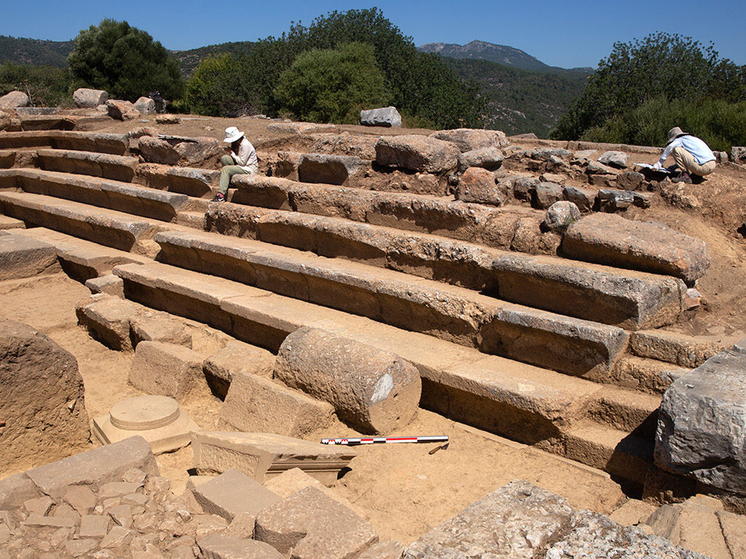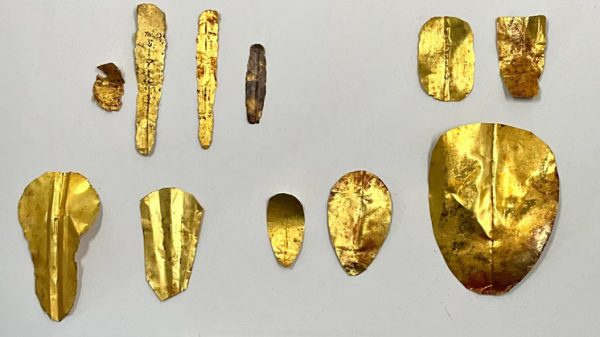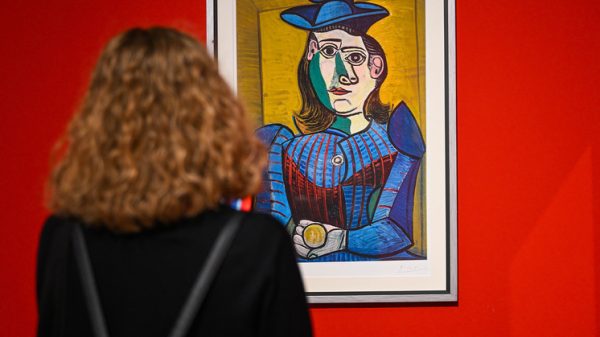Treasure could be mercenary's savings
Experts believe that gold coins in a pot discovered in Turkey could be the savings of an ancient Greek mercenary. Ongoing excavations at an ancient city in western Turkey have uncovered artifacts and archaeological finds dating back to the fifth century BC, including a pot filled with an unknown amount of valuable gold coins that was hidden more than 2,000 years ago.
 Photo: Notion Archaeological Project, University of Michigan
Photo: Notion Archaeological Project, University of Michigan
Researchers have discovered the cache at Conception, an 80-acre fortified ancient Greek city that was occupied from roughly the sixth century B.C. to the first century A.D., CNN reports. Buried — likely intentionally — beneath the floor of a courtyard house in the fifth century B.C., the “fortune” may tell the story of an ancient mercenary soldier during that conflict-ridden time, according to a University of Michigan press release.
“It’s rare to find such a valuable find in a controlled archaeological excavation,” said excavation leader Dr. Christopher Ratte, a professor of ancient Mediterranean art and archaeology at the University of Michigan and director of the Notion Archaeology Project.
“Nobody ever buries coins, especially those made of precious metals, without the intention of retrieving them. Thus, only the greatest misfortune can explain the preservation of such a treasure,” the scientist believes.
The ancient site includes typical features of an ancient Greek city, such as a theatre, temples, town houses and a market square. The site remained virtually untouched and unexplored for thousands of years until about a decade ago, when Dr Ratte and a team of researchers began aerial photography and mapping the visible remains of the city, which turned out to date back to the Hellenistic era (323-30 BC).
But when researchers began excavating in 2022 to study the remains that aren't visible from the surface, they made a fascinating discovery: Under the foundations of a large Hellenistic courtyard townhouse, they found the remains of an older home with pottery fragments in the walls dating back to the fifth century B.C. liberation. The researchers then discovered a hoard of coins buried under the floor of the older home.
The artifacts tell the story of those who lived in the city not only between the reign of Alexander the Great and the Roman Empire, but also hundreds of years before that, when tensions were high between Greek civilization and the Persian Empire, CNN reports.
The newly discovered coins date to the Persian Empire (sixth century B.C. to about 330 B.C.) and are known as Persian darics because of the image of a kneeling archer on the obverse of the coin, which depicts the Persian king Darius. Like most ancient coins from the sixth to fourth centuries B.C., the currency is not dated, which poses a problem for researchers who want to pinpoint when it was made, said Dr. Peter van Alphen, chief curator of the American Numismatic Society, who was not involved in the excavation.
“Several huge daric hoards containing thousands of coins have been found in the past, but they were not found by archaeologists, so the coins were scattered and information about the hoard was lost forever,” Pieter van Alphen wrote in an email. “The fact that this daric hoard was found in a controlled archaeological excavation is rare. The archaeological context of this hoard can provide absolute dating for certain types of daric coins.”
According to Dr. Ratte, the coins underwent minor stylistic changes during the 200 years they were in production, which the researchers tried to arrange in chronological order. The discovery of the coins, along with the dating data, allows scientists to understand why the coin was so valuable for its time.
It is unclear what exactly this valuable coin was used for, but Peter van Alphen says it is possible that it was a way to pay mercenaries. According to the University of Michigan, one gold coin was equivalent to a month's pay for a mercenary soldier. Silver coins were more often used for everyday expenses, such as going to the store. They were known as Persian silver sigloi20, which were worth one gold coin.
“The fact that this hoard was found in a house suggests that, whatever the purpose of those who produced the darics, in this case they were used as a storehouse of wealth,” van Alphen said. Because of the high value of a gold coin, “it was much more efficient to store wealth in gold coins than in silver,” he added.
As for why the owner never returned for the gold, Ratte suggested that it could indicate that the city was a frontier between Greek civilization and the Persian Empire during centuries of conflict. He suggested several scenarios could have led to the loss of the coins, including one in 427 B.C., when an Athenian general attacked a group of Persian mercenaries and massacred them.
Another such clash occurred in the late fifth century B.C., when a Spartan fleet defeated the Athenians in battle and they were forced to evacuate the city, he added.
It’s also possible that the cache belonged to a wealthy citizen who hoped to one day live like a king, such as “the incredibly wealthy Pythias (an ancient Greek architect) who had about 4 million darics in his treasury, as Herodotus reports,” van Alphen said.
































































Свежие комментарии